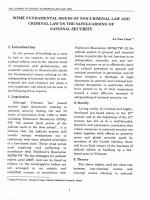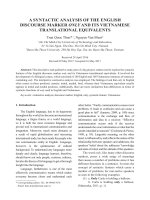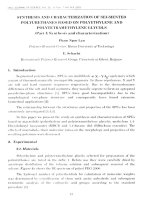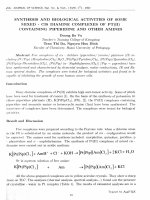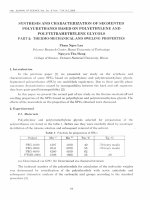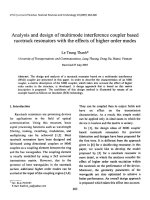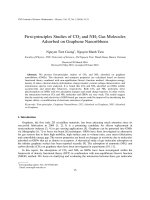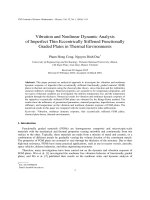DSpace at VNU: Syntheses and Structures of Nitridorhenium(V) and Nitridotechnetium(V) Complexes with N,N-[(Dialkylamino)(thiocarbonyl)-N '-(2-hydroxyphenyl)benzamidines
Bạn đang xem bản rút gọn của tài liệu. Xem và tải ngay bản đầy đủ của tài liệu tại đây (226.42 KB, 4 trang )
ARTICLE
DOI: 10.1002/zaac.201100134
Syntheses and Structures of Nitridorhenium(V) and Nitridotechnetium(V)
Complexes with N,N-[(Dialkylamino)(thiocarbonyl)]-N'-(2hydroxyphenyl)benzamidines
Hung Huy Nguyen,*[a] Thi Nguyet Trieu,[a] and Ulrich Abram*[b]
Keywords: Rhenium; Technetium; Tridentate benzamidine; Nitrido complexes; Structure analysis
Abstract. [MNCl2(PPh3)2] complexes (M = Re, Tc) react with N-[(dialkylamino)(thiocarbonyl)]-N'-(2-hydroxyphenyl)benzamidines (H2L1)
with formation of neutral, five-coordinate nitrido complexes of the
composition [MN(L1)(PPh3)]. The products have distorted squarepyramidal coordination spheres with each a tridentate, double-deprotonated benzamidine and a PPh3 ligand in their basal planes.
Introduction
phenyl)benzamidines (H2L1) has been intensively studied.
Most of the isolated complexes with these ligands have oxorhenium(V) or oxotechnetium(V) cores. Five-coordinate oxorhenium(V) and oxotechnetium (V) complexes,[2] as well as
cis methoxo compounds,[5] ‘3+2’ mixed-ligand complexes,[6]
and dimeric oxorhenium(V) complexes[5] were isolated and
structurally characterized. Only one exceptional compound is
an octahedral technetium(III) complex.[2] In continuation of
our systematic studies on thiocarbamoylbenzamidinato complexes of rhenium and technetium, here we report the synthesis
and molecular structures of nitridorhenium(V) and nitridotechnetium(V) complexes with ligands of the type H2L1.
Despite the fact that bidentate N-[(dialkylamino)(thiocarbonyl)]benzamidines (I) are well known chelators and a large
number of their complexes with many transition metal ions,
such as Ni2+, Pd2+, Pt2+, Co3+, Cu2+, Ag+, and Au+ have been
extensively studied during the last three decades,[1] surprisingly less is known about tridentate benzamidines. Recently,
we have reported about such ligands (II), which can be prepared by reactions of benzimidoyl chlorides with functionalized primary amines.[2] These ligand systems allow a variety
of modifications in the periphery of their chelating system,
which tune their properties and also give access to amino acid
derivatives and bioconjugation.[3] Some complexes of the new
ligands, preferably derivatives of thiosemicarbazides, reveal
promising cytotoxic properties against human MCF-7 breast
cancer cells.[4]
Particularly the coordination chemistry of rhenium and technetium with N-[(dialkylamino)(thiocarbonyl)]-N'-(2-hydroxy* Dr. N. H. Huy
E-Mail:
* Prof. Dr. U. Abram
Fax: +49-30-838-2676
E-Mail:
[a] Inorganic Chemistry Department
Hanoi University of Science
19 Le Thanh Tong
Hanoi, Vietnam
[b] Institute of Chemistry and Biochemistry
Freie Universität Berlin
Fabeckstrasse 34–36
14195 Berlin, Germany
1330
Results and Discussion
[MNCl2(PPh3)2] compounds (M = Re, Tc) are common starting materials for the synthesis of ReV and TcV nitrido complexes. The compounds are sparingly soluble in organic solvents. However, they slowly dissolve in stirred solutions of
H2L1 in CH2Cl2 at room temperature with formation of deep
red solutions, from which red crystalline products of the composition [MN(L1)(PPh3)] (M = Re, Tc) can be isolated in high
yields. The addition of a supporting base like Et3N accelerates
the
consumption
of
[ReNCl2(PPh3)2],
whereas
[TcNCl2(PPh3)2] is more labile than its analogous rhenium
compound and readily reacts with the ligand without the addition of a base (Scheme 1). The complexes are readily soluble
in polar organic solvents such as CHCl3 or THF. They are
stable as solids as well in solution. Their structures were studied by common spectroscopic methods.
Infrared spectra of the complexes exhibit strong bathochromic shifts of the νC=N stretches from the range between 1610
and 1620 cm–1 of the non-coordinated benzamidines to the
1510 cm–1 region. This indicates chelate formation with a large
degree of π-electron delocalization within the chelate rings and
has been observed before for the corresponding oxo
complexes.[2] The absence of absorptions in the regions around
© 2011 WILEY-VCH Verlag GmbH & Co. KGaA, Weinheim
Z. Anorg. Allg. Chem. 2011, 637, 1330–1333
Nitridorhenium(V) and Nitridotechnetium(V) Complexes
The structure of [TcN(L1b)(PPh3)] is virtually identical. Thus,
no extra Figure is presented for the technetium compound. The
corresponding bond lengths and angles, however, are also contained in Table 1.
Scheme 1. Reactions of [MNCl2(PPh3)2] (M = Re, Tc) with H2L1. The
addition of NEt3 is only required for the rhenium compound (see text).
3350 cm–1 and 3150 cm–1, in which the νNH and νOH stretches
are detected in the spectra of the uncoordinated H2L1, indicates
the expected double deprotonation of the ligands during complex formation. Absorption bands of medium intensity around
1065 cm–1 are assigned to Re≡N and Tc≡N stretches.[7]
The NMR spectra of the complexes provide additional evidence for the proposed composition and the molecular structures of the complexes. A hindered rotation around the C–NR2
bonds results in magnetic inequivalence of the two residues R.
Thus, two triplet signals of the methyl groups in the –NEt2
residues are observed in the 1H NMR spectra of
[ReN(L1a)(PPh3)] and [TcN(L1a)(PPh3)] at room temperature.
However, the proton signals of the two methylene groups,
which should consequently be two quartet signals, appear as
four multiplet resonances including two overlapping signals
at 3.80 ppm and two well separated signals at 3.68 ppm and
4.17 ppm in the spectrum of the rhenium compound. This pattern of the methylene signals can be explained by the rigid
structure of the tertiary amine group, which makes the methylene protons magnetically inequivalent with respect to their axial and equatorial positions. The rigidity of morpholinyl moiety
of {L1b}2– in [ReN(L1b)(PPh3)] results in four broad singlet
signals at 3.59, 3.81, 3.96, and 4.32 ppm, which correspond to
two CH2–N protons and two CH2–O protons. The signals of
four other protons appear as two overlapping broad singlet signals at 3.70 and 4.16 ppm. Similar coupling patterns are observed in the spectra of the corresponding technetium complexes.
The 13C NMR spectra of the complexes are easier to explain,
since their patterns are only influenced by hindered rotation
around the C–NR2 bonds. Consequently, two separated signals
for each CH2 and CH3 carbon atoms in the NEt2 groups and/
or CH2–N and CH2–O atoms in the morpholinyl units appear.
The presence of triphenylphosphine ligands in the coordination
sphere of the products is confirmed by each one singlet signal
in their 31P NMR spectra, appearing around 30.0 ppm for the
rhenium compounds and around 45 ppm for the technetium
complexes.
ESI+ mass spectra of the rhenium complexes show intense
signals corresponding to the expected [M + Na]+ and [M + H]+
ions.
X-ray structure analyses were performed for [ReN(L1b)(PPh3)]
and [TcN(L1b)(PPh3)]. Suitable single crystals were obtained by
slow evaporation of CH2Cl2/MeOH solutions of the compounds.
Figure 1 illustrates the molecular structure of the rhenium complex. Selected bond lengths and angles are presented in Table 1.
Z. Anorg. Allg. Chem. 2011, 1330–1333
Figure 1. Ellipsoid representation of the molecular structure of
[ReN(L1b)(PPh3)]. Hydrogen atoms are omitted for clarity. Thermal
ellipsoids represent 50 per cent probability.
Table 1. Selected bond lengths /Å and angles /° in [MN(L1b)(PPh3)]
(M = Re, Tc) complexes The atomic labeling scheme of Figure 1 is
also applied for the technetium complex.
M–N10
M–P
M–S1
M–N5
M–O57
S1–C2
C2–N3
N3–C4
C4–N5
C2–N6
N10–M–P
N10–M–S1
N10–M–N5
N10–M–O57
P–M–N5
O57–M–S1
[ReN(L1b)(PPh3)]
[TcN(L1b)(PPh3)]
1.645(6)
2.418(1)
2.316(1)
2.084(4)
2.026(4)
1.764(6)
1.338(8)
1.310(8)
1.354(7)
1.336(8)
92.6(2)
104.7(2)
107.8(2)
111.5(2)
158.0(1)
143.8(1)
1.619(5)
2.436(1)
2.330(1)
2.091(4)
2.029(4)
1.758(6)
1.341(7)
1.335(8)
1.327(8)
1.330(8)
93.3(2)
104.9(2)
107.7(2)
112.0(2)
157.9(1)
143.0(1)
The metal atoms show distorted square-pyramidal coordination spheres with the nitrido ligands in apical positions. Such
an assignment of the molecular geometry is supported by the
corresponding τ values of 0.25 (technetium compound) and
0.24 (rhenium complex). They clearly indicate that the complexes under study are better described with a square-pyramidal coordination sphere (τ = 0) than as trigonal bipyramids (τ =
1). The thiocarbamoylbenzamidines coordinate meridional to
the metal atoms as tridentate dianionic ligands as in their previously reported oxo complexes. The remaining positions in the
basal planes of the square pyramids are occupied each by a
triphenylphosphine ligand. The metal atoms lie above the
equatorial planes towards the nitrido ligands by 0.528(2) Å for
© 2011 WILEY-VCH Verlag GmbH & Co. KGaA, Weinheim
www.zaac.wiley-vch.de
1331
ARTICLE
H. H. Nguyen, T. N. Trieu, U. Abram
the rhenium complex and 0.544(2) Å for the technetium compound. The N10–Re–X angles (X = equatorial donor atom) fall
in the range between 92.6 and 111.5°, the corresponding N10–
Tc–X angles are between 93.3 and 112.0°. These values are in
complete agreement with the typical bonding situation of
square-pyramidal ReVN and TcVN complexes.[8]
The Re–N10 and Tc–N10 distances of 1.645(6) and
1.619(5) Å are within the expected range of rhenium or technetium–nitrogen triple bonds.[9] The six-membered chelate rings
are strongly distorted for both complexes, with main deviations
of 0.413(4) Å (rhenium complex) and 0.419(4) Å (technetium
complex) from the mean least-square planes each for the nitrogen atoms N5. Nevertheless, a considerable delocalization of
π-electron density is observed. This is indicated by the C–S and
C–N bond lengths inside the chelate rings, which all fall within
the range between carbon–sulfur and carbon–nitrogen single
and double bonds. This bond length equalization is even
extended to the C2–N6 bonds, which are significantly shorter
than expected for single bonds. All the MO, MN and M–S
bonds are slightly longer than those in the corresponding oxo
complexes.[2,5] This can be understood by the larger steric bulk
of the M≡N triple bond, which results in larger
N≡MX(equatorial) angles and consequently in a somewhat less
effective overlap between the ligand and the d orbitals of the
metal ions. Details have been discussed previously on a series
of oxo, nitrido and phenylimido compounds of technetium and
rhenium with 1,2-dicyanoethene-1,2-dithiolate.[10]
Conclusions
The ready synthesis and the stability of the nitrido complexes
under study and the promising biological properties of the related oxo compounds[2–4] recommend transition metal complexes with ligands of the thiocarbamoylbenzamidine family
for further consideration with regard to medical and nuclear
medical applications. Ongoing studies with tri- to pentadentate
ligands with peripheral coupling positions for biomolecules are
presently underway in our laboratories. They also include nitrido complexes with the ligands discussed in this paper as
well as tetradentate systems derived from diamines.
Experimental Section
Materials and Measurements
All reagents used in this study were reagent grade and used without
further purification. Solvents were dried and used freshly distilled unless otherwise stated. [ReNCl2(PPh3)2][11] and [TcNCl2(PPh3)2][12] were
prepared by standard procedures. The synthesis of H2L1 ligands were
described in a previous paper.[2]
Infrared spectra were recorded from KBr pellets with a Shimadzu FT
instrument in the range 400–4000 cm–1. Positive electrospray ionization mass spectra (ESI+ MS) were measured with an Agilent 6210 ESITOF (Agilent Technologies) (results are given in the form: m/z, %
based peak, assignment). Elemental analyses were determined using
a Heraeus vario EL elemental analyzer. The technetium content was
determined by liquid scintillation measurements. NMR spectra were
taken at 25 °C with a JEOL 400 MHz multinuclear spectrometer.
1332
www.zaac.wiley-vch.de
Radiation Precautions
99
Tc is a weak β- emitter. All manipulations with this isotope were
performed in a laboratory approved for the handling of radioactive
materials. Normal glassware provides adequate protection against the
low-energy β- emission of the technetium compounds. Secondary Xrays (bremsstrahlung) play an important role only when larger amounts
of 99Tc are used.
Synthesis of [ReN(L1)(PPh3)]
Solid [ReNCl2(PPh3)2] (80 mg, 0.1 mmol) was added to a stirred solution of H2L1 (0.1 mmol) in CH2Cl2 (5 mL). The mixture was stirred
at room temperature for 15 min and then 3 drops of Et3N were added.
This resulted in a complete dissolution of [ReNCl2(PPh3)2] and the
formation of a red solution. The solvent was removed under vacuum,
and the residue was crystallized by slow evaporation of a CH2Cl2/
MeOH solution as red blocks. The side products (HNEt3)Cl and PPh3
remain in the residual MeOH. Alternatively, the crude reaction product
can be washed twice with methanol before re-dissolution in CH2Cl2
for crystallization.
Data for [ReN(L1a)(PPh3)] (R1 = R2 = Et): Yield: 60 mg, 76 %. Elemental analysis. Calcd. for C36H34N4OPSRe: C, 54.88; H, 4.35; N,
7.11; S, 4.07 %. Found: C, 54.78; H, 4.30; N, 7.07; S, 4.15 %. IR:
ν = 3059 (w), 2978 (w), 2932 (w), 1512 (vs), 1492 (vs), 1477 (vs),
1439 (s), 1393 (m), 1354 (m), 1254 (vs), 1096 (m), 1065 (m), 1026
(w), 744 (m), 686 (s), 528 (s), 505 (m). 1H NMR (CDCl3): δ = 1.08
(t, J = 7.0 Hz, 3 H, CH3), 1.26 (t, J = 7.1 Hz, 3 H, CH3), 3.68 (m, 1
H, CH2), 3.80 (m, 2 H, CH2), 4.17 (m, 1 H, CH2), 6.27 (t, J = 7.6 Hz,
1 H, PhOH), 6.47 (d, J = 7.8 Hz, 1 H, PhOH), 6.62 (t, J = 7.0 Hz, 1
H, PhOH), 6.83 (d, J = 7.8 Hz, 1 H, PhOH), 7.26 (t, J = 7.3 Hz, 2 H,
Ph), 7.35 (m, 10 H, Ph + PPh3), 7.79 (m, 8 H, Ph + PPh3). 13C NMR
(CDCl3): δ = 12.8, 13.2 (CH3), 46.3, 47.7 (CH2), 117.0–135.8
(Caromatic), 141.3 (Caromatic–N), 162.1 (Caromatic–O), 166.8 (C=N), 171.6
(C = S). 31P NMR (CDCl3): δ = 29.6 (s). ESI+ MS (m/z): 811, 100 %,
[M + Na]+; 789, 40 %, [M + H]+.
Data for [ReN(L1b)(PPh3)] (NR1R2 = morph): Yield: 64 mg, 80 %.
Elemental analysis. Calcd. for C36H32N4O2PSRe: C, 53.92; H, 4.02; N,
6.99; S, 4.00 %. Found: C, 53.87; H, 4.15; N, 7.10; S, 4.09 %. IR: ν =
3051 (w), 2970 (w), 2905 (w), 2858 (w), 1507 (vs), 1477 (vs), 1435
(s), 1388 (s), 1357 (w), 1257 (s), 1219 (m), 1096 (m), 1068 (m), 1026
(m), 745 (m), 690 (s), 528 (s), 505 (m). 1H NMR (CDCl3): δ = 3.59
(br. s, 1 H, NCH2), 3.70 (br. s, 2 H, NCH2), 3.81 (br. s, 1 H, NCH2),
3.96 (br. s, 1 H, OCH2), 4.16 (br. s, 2 H, OCH2), 4.32 (br. s, 1 H,
OCH2), 6.27 (t, J = 7.6 Hz, 1 H, PhOH), 6.49 (d, J = 7.8 Hz, 1 H,
PhOH), 6.64 (t, J = 7.6 Hz, 1 H, PhOH), 6.84 (d, J = 7.9 Hz, 1 H,
PhOH), 7.27 (t, J = 7.3 Hz, 2 H, Ph), 7.37 (m, 10 H, Ph + PPh3), 7.77
(m, 8 H, Ph +PPh3). 13C NMR (CDCl3): δ = 48.8, 49.7 (NCH2), 66.7,
66.9 (OCH2), 117.2–135.7 (Caromatic), 140.9 (Caromatic–N), 163.0
(Caromatic–O), 167.1 (C=N), 171.3 (C = S). 31P NMR (CDCl3): δ = 28.8
(s). ESI+ MS (m/z): 825, 100 %, [M + Na]+; 803, 40 %, [M + H]+.
Synthesis of [TcN(L1)(PPh3)].
The technetium complexes were prepared following the procedure described for their analogous rhenium complexes except that the precursor [TcNCl2(PPh3)2] was used and no NEt3 was added.
Data for [TcN(L1a)(PPh3)] (R1 = R2 = Et): Yield: 59 mg, 84 %. Elemental analysis. Calcd. for C36H34N4OPSTc: Tc, 14.1 %. Found: Tc,
14.1 %. IR: ν = 3051 (w), 2970 (w), 2924 (w), 1504 (vs), 1477 (vs),
© 2011 WILEY-VCH Verlag GmbH & Co. KGaA, Weinheim
Z. Anorg. Allg. Chem. 2011, 1330–1333
Nitridorhenium(V) and Nitridotechnetium(V) Complexes
1434 (s), 1396 (m), 1350 (m), 1307 (m), 1258 (vs), 1095 (m), 1057
(m), 1026 (w), 798 (m), 741 (m), 690 (s), 528 (s), 497 (m) cm–1. 1H
NMR (CDCl3): δ = 1.09 (t, J = 7.1 Hz, 3 H, CH3), 1.26 (t, J = 7.1 Hz,
3 H, CH3), 3.67 (m, 1 H, CH2), 3.75 (m, 2 H, CH2), 4.00 (m, 1 H,
CH2), 6.23 (t, J = 7.5 Hz, 1 H, PhOH), 6.37 (d, J = 7.7 Hz, 1 H,
PhOH), 6.63 (t, J = 7.1 Hz, 1 H, PhOH), 6.79 (d, J = 7.8 Hz, 1 H,
PhOH), 7.26 (t, J = 7.4 Hz, 2 H, Ph), 7.30 (m, 10 H, Ph + PPh3), 7.73
(m, 8 H, Ph + PPh3). 31P NMR (CDCl3): δ = 45.4 (s).
Data for [TcN(L1b)(PPh3)] (NR1R2 = morph): Yield: 63 mg, 89 %.
Elemental analysis. Calcd. for C36H32N4O2PSTc: Tc, 13.8 %. Found:
Tc, 13.9 %. IR: ν = 3051 (w), 2970 (w), 2909 (w), 2843 (w), 1498
(vs), 1477 (vs), 1431 (s), 1400 (s), 1357 (w), 1312 (m), 1265 (s), 1215
(m), 1095 (m), 1060 (m), 1026 (m), 844 (m), 748 (s), 691 (s), 524 (s),
505 (m) cm–1. 1H NMR (400 MHz, CDCl3): δ = 3.61 (br. s, 1 H,
NCH2), 3.70 (m, 2 H, NCH2), 3.76 (br. s, 1 H, NCH2), 3.98 (br. s, 1
H, OCH2), 4.05 (br. m, 2 H, OCH2), 4.20 (br. s, 1 H, OCH2), 6.22 (t,
J = 7.5 Hz, 1 H, PhOH), 6.38 (d, J = 7.8 Hz, 1 H, PhOH), 6.65 (t, J =
7.6 Hz, 1 H, PhOH), 6.79 (d, J = 7.8 Hz, 1 H, PhOH), 7.22 (t, J =
7.4 Hz, 2 H, Ph), 7.34 (m, 10 H, Ph + PPh3), 7.71 (m, 8 H, Ph +
PPh3). 31P NMR (CDCl): δ = 44.6 (s).
X-ray Crystallography
The X-ray diffraction data were collected with a STOE IPDS diffractometer with Mo-Kα radiation. The structures were solved by the Patterson method using SHELXS-97.[13] Subsequent Fourier-difference
map analyses yielded the positions of the non-hydrogen atoms. Refinement was performed using SHELXL-97.[13] The positions of hydrogen
atoms were calculated for idealized positions and treated with the ‘rid-
Table 2. Crystal data and refinement results.
Formula
Mw /g·mol–1
Crystal system
a /Å
b /Å
c /Å
α /°
β /°
γ /°
V /Å3
Space group
Z
Dcalcd. /g·cm–3
μ /mm–1
No. of reflections
No. of independent /Rint
No. parameters
R1/wR2
GOF
Deposit reference number
[ReN(L1b)(PPh3)]
[TcN(L1b)(PPh3)]
C36H32N4O2PReS
801.89
triclinic
9.473(1)
11.650(1)
15.423(1)
95.04(1)
95.96(1)
108.32(1)
1593.9(2)
P1¯
2
1.671
3.968
17391
8499 / 0.1023
406
0.0422 / 0.0901
0.937
816874
C36H32N4O2PSTc
713.69
triclinic
9.454(1)
11.656(1)
15.451(1)
94.76(1)
95.41(1)
108.45(1)
1596.3(2)
P1¯
2
1.485
0.606
17115
8518 / 0.1245
407
0.0711 / 0.1378
0.988
816875
Z. Anorg. Allg. Chem. 2011, 1330–1333
ing model’ option of SHELXL-97. Crystal data and more details of the
data collections and refinements are contained in Table 2. Additional
information on the structure determinations have been deposited at the
Cambridge Crystallographic Data Centre.
Acknowledgement
We thank the Deutscher Akademischer Austauschdienst (DAAD) for
generous support. H. H. Nguyen is additionally grateful to Vietnam’s
National Foundation for Science and Technology Development for the
financial support through project 104.02–2010.31.
References
[1] a) J. Hartung, G. Weber, L. Beyer, R. Szargan, Z. Anorg. Allg.
Chem. 1985, 523, 153; b) R. del Campo, J. J. Criado, E. Garcia,
M. R. Hermosa, A. Jimenez-Sanchez, J. L. Manzano, E. Monte,
E. Rodriguez-Fernandez, F. Sanz, J. Inorg. Biochem. 2002, 89,
74; c) W. Hernandez, E. Spodine, R. Richter, K. H. Hallmeier, U.
Schröder, L. Beyer, Z. Anorg. Allg. Chem. 2003, 629, 2559; d) U.
Schröder, R. Richter, L. Beyer, J. Angulo-Cornejo, M. Lino-Pacheco, A. Guillen, Z. Anorg. Allg. Chem. 2003, 629, 1051; e) E.
Guillon, I. Dechamps-Olivier, A. Mohamadou, J.-P. Barbier, Inorg. Chim. Acta 1998, 268, 13; f) R. Richter, U. Schröder, M.
Kampf, J. Hartung, L. Beyer, Z. Anorg. Allg. Chem. 1997, 623,
1021.
[2] H. H. Nguyen, J. Grewe, J. Schroer, B. Kuhn, U. Abram, Inorg.
Chem. 2008, 47, 5136.
[3] a) H. H. Nguyen, U. Abram, Polyhedron 2009, 28, 3945; b) J.
Schroer, U. Abram, Polyhedron 2009, 28, 2277.
[4] H. H. Nguyen, J. J. Jegathesh, P. I. da S. Maia, V. M. Deflon, R.
Gust, S. Bergemann, U. Abram, Inorg. Chem. 2009, 48, 9356.
[5] H. H. Nguyen, K. Hazin, U. Abram, Eur. J. Inorg. Chem. 2011,
78.
[6] H. H. Nguyen, V. M. Deflon, U. Abram, Eur. J. Inorg. Chem.
2009, 3179.
[7] C. Bolzati, M. Cavazza-Ceccato, S. Agostini, F. Tisato, G. Bandoli, Inorg. Chem. 2008, 47, 11972.
[8] C. Bolzati, F. Refosco, A. Cagnolini, F. Tisato, A. Boschi, A.
Duatti, L. Uccelli, A. Dolmella, E. Marotta, M. Tubaro, Eur. J.
Inorg. Chem. 2004, 1902.
[9] a) U. Abram, Rhenium, in: Comprehensive Coordination Chemistry II (Eds.: J. A. McCleverty, T. J. Mayer), Elsevier, Amsterdam,
The Netherlands, 2003;Vol. 5, p. 271; b) R. Alberto, Technetium,
in: Comprehensive Coordination Chemistry II (Eds.: J. A.
McCleverty, T. J. Mayer), Elsevier, Amsterdam, The Netherlands,
2003;Vol. 5, p. 127.
[10] B. Kuhn, U. Abram, Z. Anorg. Allg. Chem. 2011, 637, 242.
[11] J. Chatt, J. D. Garforth, N. P. Johnson, G. A. Rowe, J. Chem. Soc.
1964, 1012.
[12] U. Abram, B. Lorenz, L. Kaden, D. Scheller, Polyhedron 1988,
7, 285.
[13] G. M. Sheldrick, SHELXS-97 and SHELXL97, Programs for the
Solution and Refinement of Crystal Structures, University of
Göttingen, Germany, 1997.
© 2011 WILEY-VCH Verlag GmbH & Co. KGaA, Weinheim
Received: March 21, 2011
Published Online: June 6, 2011
www.zaac.wiley-vch.de
1333
